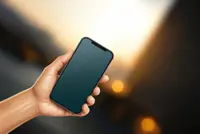About 70% of high school teachers and one-third of middle school teachers say that students being distracted by cellphones is a major problem in their classrooms, according to the Pew Research Center. But there’s hope. Samuels, the KIPP NYC College Prep principal, said it took less than a year after the ban for academic performance to improve. — Dreamstime/TNS
Signs of withdrawal began to show immediately.
At a high school in upstate New York that had banned mobile phones, a student was constantly reaching for her nonexistent device and grabbing air. Hallways rang with the sound of kids trying to smash locks and get to their devices. At another school in the Bronx, students plotted a protest.
Eventually, though, the symptoms faded and behaviour changed. At KIPP NYC College Prep high school, AP test scores increased and grades bounced back to pre-pandemic averages, according to Principal Monica Samuels.
She said some students even covertly thanked her for instituting the ban, which made it easier for them to focus. And the school saw changes after hours, too: Attendance at sporting events and other activities jumped by 50%.
At Newburgh Free Academy high school, classroom engagement improved after students gave up on busting their phones out of jail. The lunchroom got a lot noisier as the kids switched to playing card games instead of watching TikTok videos.
“And in our classrooms, when you would actually speak to them, you had their attention,” said Kate Sinnott, a math teacher in Newburgh for the past 16 years. Previously, classrooms had been a sea of heads looking down at their phones, she said.
The two schools offer a window into what is potentially in the offing for students in New York City, the nation’s largest district, after Chancellor David Banks said he plans an across-the-board ban on mobile phones for more than 1.1 million public-school students at 1,800 campuses. Gov Kathy Hochul has said she also intends to propose a statewide ban in schools during the 2025 legislative session.
Banks hasn’t formally announced the policy, but it comes amid a nationwide reckoning over the potential harms of mobile phones that provide constant access to social media, prompting warnings from the Surgeon General and bans in school districts around the country, including Los Angeles.
‘Devastating effects’
New York City schools had been left to set policies on their own since 2015, when Mayor Bill de Blasio ended a phone ban initially put in place by his predecessor, Michael Bloomberg.
In a Bloomberg Opinion column in June, he renewed his call to ban the devices in New York schools, citing their “devastating effects on learning”. The former mayor is the founder and majority owner of Bloomberg LP, the parent of Bloomberg News.
Zach Rausch, lead researcher for Jonathan Haidt’s bestselling book, The Anxious Generation – which looks at technology’s effects on mental health – said bans like the one planned by New York City are one of the most effective ways to get addictive devices away from children.
“Kids are feeling isolated, lonely, disconnected. They’re also performing poorly in schools,” said Rausch, an associate research scientist at the NYU Stern School of Business. “A large reason for both of these problems in the infusion of addictive tech in schools.”
The first day Newburgh changed its phone policy in December, Sofia Mucci discovered a line wrapped around the building. A senior at the time, she soon learned the reason – administrators were issuing pouches that would be used to lock up phones during school.
“I’m a teenager, so I can’t say I’m a fan of them taking my phone,” Mucci said. When the ban was first implemented, she’d often reach for her device and find herself grabbing for air instead, forgetting it was locked in its pouch. “It was just too much of a habit.”
But by the end of the school year, Mucci couldn’t help noticing her improved focus during class. And during free periods once spent focused on technology, she now chatted with other students outside.
Statewide policy
Hochul said she is leaning toward pushing a statewide policy in the legislature session beginning in January.
“I don’t mind being the heavy, so I don’t anticipate a piecemeal approach will be my approach,” she said at a press conference this week.
In New York City, when the previous ban was in place, many students dropped off their phones at convenience stores before school, paying a small storage fee. Banks said schools will come up with a better alternative, though he has yet to lay out specifics.
Already, one-third of public schools in New York City require students to place their phones in lockable pouches made by the company Yondr, according to reporting from Chalkbeat. They get their device back at the end of the day, releasing them by using a magnetic tool stationed at school exits.
The San Francisco-based company took in US$2.1mil (RM9.81mil) from government contracts in 2023, a 10-fold increase from just two years earlier, according to a report by The 74 that cited data from GovSpend. One school near Albany spent almost US$27,000 (RM126,238) to start a lock-up program with 1,400 pouches.
Yondr didn’t respond to calls and emails requesting comment.
Schools that ban devices without requiring pouches also sometimes struggle to enforce the rules. Salma Baksh, a recent graduate of Forest Hills High School in Queens, noticed the toll it took on teachers to police phone usage by the school’s 3,500 students.
“If they confiscate it, they’ll be viewed negatively by all the other students,” said Baksh, who plans to start at Smith College in the fall. “It’s not the administrators or Chancellor Banks who’s going to take away the phones from students. It’s the teachers.”
The United Federation of Teachers, the union that represents New York City educators, is studying the experiences of schools that have already instituted bans, according to Michael Mulgrew, its president.
Asking educators to hang onto phones for the day can also turn costly if something goes wrong. Before Bronx Latin high school started using Yondr pouches, assistant principal Anna Nelson had to pay out of pocket for two confiscated phones – one that fell in the toilet, and one that was misplaced.
Major problem
About 70% of high school teachers and one-third of middle school teachers say that students being distracted by cellphones is a major problem in their classrooms, according to the Pew Research Center. But there’s hope. Samuels, the KIPP NYC College Prep principal, said it took less than a year after the ban for academic performance to improve.
Still, some kids and parents are worried about students not having their phones in an emergency. When a gunman went on a shooting spree at a school in Parkland, Florida, in 2018, students inside the school sent texts to parents about what was happening.
Education safety experts note, however, that devices can make emergencies worse, like when notifications distract students from hearing important instructions. Sometimes, parents show up at a school during an emergency, contributing to chaotic situations.
For schools that do pursue a ban, Rausch noted that it doesn’t have to feel like a punitive measure. Instead, it can be tied to other new policies, like more time devoted specifically to recreation.
“The work of childhood is to play – and we need to do a ton of it,” Rausch said. “We’re gonna say seven hours of the school day is going to be focused on paying attention to other human beings in person with each other. And we believe that that will have a really dramatic impact on the young people’s mental health.” – Bloomberg





